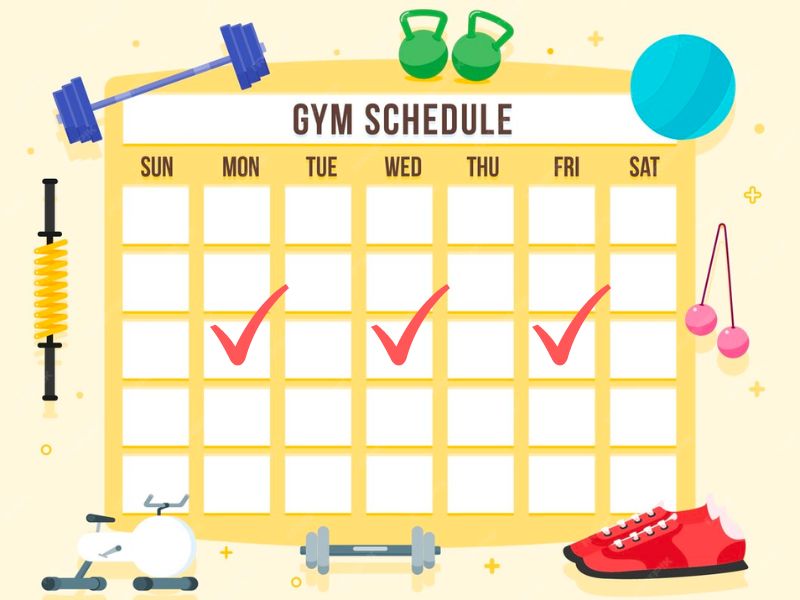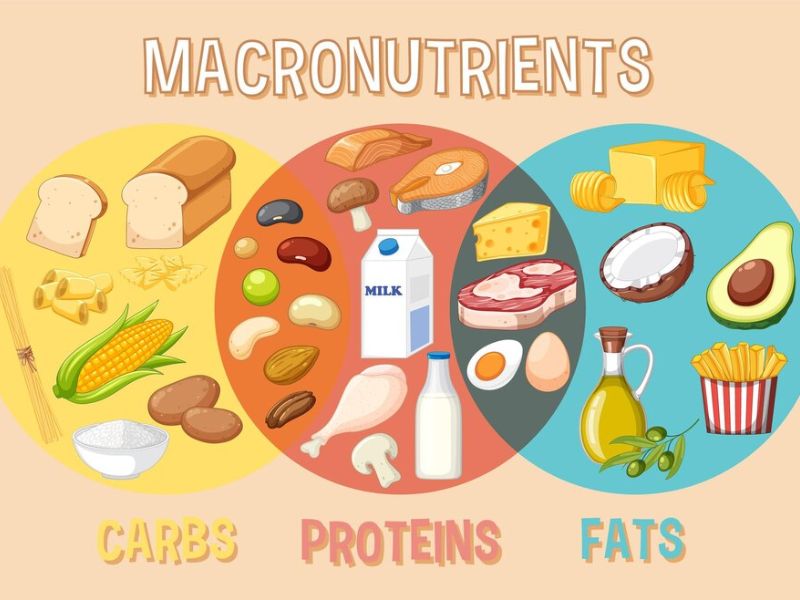Have you ever dreamt of feeling stronger, healthier, and more confident?
Strength training can be your key to unlocking these goals and transforming your life.
But forget bulky weightlifters and grueling routines.
This program is designed especially for beginners, offering a clear roadmap to gradually build strength and improve your overall well-being.
Here’s a surprising fact: strength training isn’t just about aesthetics.
A study published in the Journal of Applied Physiology found that resistance training increased muscle mass by 8% in healthy adults after just 12 weeks [*].
That’s right, strength training goes far beyond sculpting a beach bod.
It boasts a treasure trove of benefits that can significantly enhance your health and quality of life:
Understanding the strength training program

Imagine this: You walk past the mirror and sigh. Your clothes feel a bit tighter, and that nagging back pain from sitting at your desk all day just won’t quit.
You know you want to feel stronger, healthier, and maybe even rock a new outfit with confidence, but traditional cardio just isn’t cutting it anymore.
This is a scenario countless beginners face. They’re ready to ditch the treadmill and take control of their fitness journey, but weight training can seem intimidating.
Here’s the good news: Strength training, or Muscle Building is your secret weapon for a total body transformation, and it’s easier (and way more rewarding) than you think!
What is a Strength Training Program?

Think of a strength training program as your personalized roadmap to building a stronger, healthier you.
It involves systematically challenging your muscles with exercises that make them work harder.
This doesn’t have to mean grunting and lifting barbells heavier than yourself (although you can get there if that’s your goal!).
It can start with simple bodyweight exercises or lighter weights, gradually increasing intensity over time.
Benefits of Strength Training for Beginners
Here’s where things get exciting. Strength training isn’t just about sculpting beach bodies (although that can be a perk!).
It boasts a treasure trove of benefits that go far beyond aesthetics:
1. Increased Muscle Mass and Strength:

Imagine feeling effortlessly stronger during everyday activities, from carrying groceries to climbing stairs.
Strength training builds lean muscle tissue, which is your body’s metabolic engine. The more muscle you have, the more calories you burn at rest, even while watching your favorite show [*].
2. Improved Bone Density:
As we age, bone density naturally declines, increasing the risk of osteoporosis.
Strength training acts like a magic potion for your bones, stimulating them to become denser and stronger.
Research from the National Institutes of Health indicates that weight-bearing exercises can significantly improve bone mineral density in the spine and hips [*].
3. Boosted Metabolism and Weight Management:

Do you feel like your weight loss has plateaued?
Strength training can help. Muscle burns more calories than fat, even when you’re not actively exercising.
This “afterburn effect” helps you manage weight more effectively in the long run.
A meta-analysis published in the American College of Sports Medicine’s journal found that resistance training combined with a healthy diet led to significantly greater weight loss compared to diet alone [*].
4. Better Posture, Flexibility, and Balance:
Goodbye slouching, hello confident posture.
Strength training strengthens the core muscles that support your spine, leading to better posture and improved balance.
Additionally, many strength training exercises involve a full range of motion, which can enhance flexibility and reduce your risk of injury.
5. Reduced Risk of Chronic Diseases:

Strength training isn’t just about aesthetics; it’s a powerful tool for promoting overall health.
Studies have shown that it can help lower blood pressure, manage blood sugar levels, and even reduce the risk of type 2 diabetes and heart disease [*].
6. Improved Mood and Sleep Quality:

Feeling stressed or sleep-deprived? Strength training can be your knight in shining armor.
Exercise releases endorphins, those feel-good chemicals that combat stress and elevate mood.
Additionally, physical exertion can improve sleep quality, leaving you feeling energized and well-rested.
7. Increased Confidence and Self-Esteem:

There’s a powerful sense of accomplishment that comes from getting stronger and pushing your limits.
Strength training isn’t just about physical transformation; it’s a journey of self-discovery that can boost your confidence and self-esteem.
Who is This Program For? You Are
Strength training isn’t just for gym rats or fitness enthusiasts. It’s for anyone who wants to feel stronger, healthier, and more confident.
Whether you’re a complete beginner or someone looking to take your fitness to the next level, a strength training program can be customized to fit your needs and goals.
What You’ll Get: A Roadmap to Success
Our program isn’t just a bunch of exercises thrown together. It’s a clear roadmap to achieving your goals. We’ll provide you with:
- Clear Goals: We’ll help you define your goals, whether it’s weight loss, building muscle, or simply feeling stronger.
- Step-by-Step Instructions: No confusion here! We’ll guide you through each exercise with proper form and technique to ensure safety and effectiveness.
Getting Started

Setting Goals Like a Boss: The Power of SMART

We’ve all been there – the vague New Year’s resolution to “get in shape.”
But how do you actually track that progress?
Enter SMART goals. Think of them as your personal GPS, guiding you towards realistic and achievable targets.
Here’s how to set SMART goals for strength training:
- Specific: Instead of “get stronger,” aim for something concrete, like “squat 100 lbs by the end of the program” or “do 15 unbroken push-ups within 3 months.”
- Measurable: Numbers are your friend! Track your progress with a weightlifting app, note down the number of reps and sets you complete, or take progress photos.
- Achievable: Be realistic but ambitious. Don’t set yourself up for failure by aiming to lift weights you can barely move in the first week. Start with a challenging but achievable goal, and gradually increase the difficulty as you get stronger.
- Relevant: Your goals should align with your overall health and fitness aspirations. Do your goals support your bigger-picture vision for yourself? If you want to run a marathon, focusing on lower body strength and endurance would be more relevant than prioritizing upper body sculpting exercises.
- Time-bound: A deadline lights a fire under you and keeps you accountable. Give yourself a specific timeframe to achieve your goal. Aim to achieve your squat goal within 12 weeks, for example.
Finding Your “Why”: The Spark That Keeps You Going
Let’s be honest, sticking with a new routine can be tough. That’s where intrinsic motivation, your “why,” comes in.
- What is your WHY? Is it to keep up with your active kids? Feel more confident in a swimsuit? Having a clear purpose fuels your dedication and gets you back on track when motivation dips.
- Find your fitness WHY: Do you enjoy the feeling of accomplishment after a tough workout? Maybe you love the stress-relieving effects of exercise. Identify what truly motivates you and use it to power your journey.
Gearing Up for Success: Choosing the Right Equipment

The good news? You don’t need a fancy gym membership to get started.
Here are some equipment options to consider:
- Bodyweight Exercises: These are a fantastic option for beginners. Push-ups, squats, lunges, and planks require zero equipment and can be done anywhere. They are a great way to establish a baseline of strength and build core stability before progressing to weighted exercises.
- Dumbbells: Versatile and affordable, dumbbells allow you to target various muscle groups. Start with lighter weights and gradually increase as you get stronger. Look for dumbbells with adjustable weights if you want to save space and money in the long run.
- Resistance Bands: Another budget-friendly option, resistance bands offer progressive resistance and can be used for a wide range of exercises. They are particularly useful for exercises that target multiple muscle groups or for adding instability to an exercise, challenging your core further.
- Gym Machines: Gyms offer a variety of weight machines that can be helpful, especially for beginners learning proper form. Machines can guide you through the movement pattern, reducing the risk of injury. However, they might not be as versatile as free weights or bodyweight exercises, which can be adapted to your fitness level and target a wider range of muscles in one exercise.
Home Gym vs. Gym: Picking Your Training Ground

Not everyone enjoys the gym atmosphere. Here’s a breakdown to help you decide:
Home Gym:
- Pros: Convenient, affordable (once you have the equipment), privacy.
- Cons: Limited equipment options, and lack of motivation from a gym environment.
Gym:
- Pros: Wider range of equipment, access to trainers for guidance, social interaction.
- Cons: Cost, can be intimidating for beginners.
The best option depends on your personality and preferences. If you’re unsure, start with bodyweight exercises at home or consider a trial gym membership to see if it suits you.
Building Your Workout Routine
Okay, you’re pumped to start strength training, but the gym floor looks like a foreign land filled with unfamiliar equipment and routines.
Don’t worry, we’ve all been there! This section will be your roadmap to building a workout routine that’s effective, safe, and most importantly, enjoyable.
Warming Up Like a Pro: Why It Matters

Imagine this: you jump straight into heavy weightlifting without any preparation. Not exactly a recipe for success, right?
A proper warm-up prepares your body for exercise, increasing blood flow to your muscles, improving flexibility, and reducing your risk of injury.
Here’s what your warm-up should look like:
- Dynamic Stretches: These stretches mimic the movements you’ll be doing in your workout. Think arm circles, leg swings, and high knees. Aim for 5-10 minutes of dynamic stretches to get your blood flowing and loosen up your joints.
- Light Cardio: A short burst of light cardio, like 5-10 minutes on the treadmill or jumping jacks, further elevates your heart rate and prepares your cardiovascular system for exercise.
Frequency is Key: How Often Should You Train?

As a beginner, 2-3 strength training sessions per week are ideal. This allows your muscles sufficient time to recover and rebuild stronger.
Focus on working all major muscle groups throughout the week. Here are some split routine options you can consider:
- Full body workouts: Hit all major muscle groups in each session, perfect for busy schedules.
- Upper/lower body splits: Train your upper body one day, and lower body the next, allowing for more focused training on each muscle group.
Remember, consistency is key! Aim for regular workouts, even if they're shorter sessions. Listen to your body and take rest days when needed.
Rest Like a Champion: How Much is Enough?

Rest periods are crucial for muscle recovery. Here’s a general guideline:
- For beginners: Aim for 30-60 seconds of rest between sets of bodyweight exercises or lighter weights.
- For heavier weights: Increase rest time to 60-90 seconds to allow your muscles to recover adequately.
Sample beginner workout plans:
Think of a workout plan as your roadmap to strength training success.
There are different approaches, each with its benefits.
We’ll explore a few popular options to help you find the perfect fit:
Full Body Workout:
This is a great option for beginners, especially those short on time. It hits all major muscle groups in one session, promoting overall strength development.
Sample Full Body Gym Workout (Beginner Level):
- Warm-up: 5 minutes of light cardio (e.g., jogging on the treadmill) and dynamic stretches (e.g., arm circles, leg swings)
- Goblet Squat: 3 sets of 10 repetitions (hold a dumbbell close to your chest)
- Dumbbell Chest Press: 3 sets of 10 repetitions
- Dumbbell Row: 3 sets of 10 repetitions per arm
- Plank: 3 sets of 30 seconds hold
- Cool-down: 5 minutes of static stretches (e.g., hamstring stretch, quad stretch)
Upper Body Workout:

This workout focuses on strengthening muscles in your chest, back, shoulders, arms, and core.
Sample Upper Body Gym Workout (Beginner Level):
- Warm-up (same as full body)
- Push-ups (modified on knees if needed): 3 sets of as many repetitions as possible (AMRAP)
- Dumbbell Shoulder Press: 3 sets of 10 repetitions
- Dumbbell Bicep Curl: 3 sets of 10 repetitions per arm
- Tricep Pushdowns (cable machine): 3 sets of 10 repetitions
- Anti-Rotational Cable Press: 3 sets of 10 repetitions per side (targets core)
- Cool-down (same as full body)
Lower Body Workout:

This workout focuses on strengthening your legs, glutes, and core.
Sample Lower Body Gym Workout (Beginner Level):
- Warm-up (same as full body)
- Bodyweight Squats: 3 sets of 12 repetitions
- Leg Press Machine: 3 sets of 10 repetitions
- Romanian Deadlift (with dumbbells): 3 sets of 10 repetitions
- Lunges (bodyweight or with dumbbells): 3 sets of 10 repetitions per leg
- Calf Raises: 3 sets of 15 repetitions
- Cool-down (same as full body)
Split Routines (Push/Pull/Legs):
As you get stronger, you might consider split routines. These target different muscle groups over separate workouts, allowing for more focused training and increased volume.
Remember: These are just samples! You can adjust exercises, sets, reps, and rest periods based on your fitness level and goals.
Bodyweight Bonanza: Workouts Without the Weights

Don’t have access to a gym? No problem! Bodyweight exercises are a fantastic way to build strength at home.
They require minimal equipment and can be easily modified for different fitness levels.
Sample Bodyweight Workout (Beginner Level):
- Warm-up (same as full body)
- Squats: 3 sets of 12 repetitions
- Push-ups (modified on knees if needed): 3 sets of AMRAP
- Lunges: 3 sets of 10 repetitions per leg
- Plank: 3 sets of 30 seconds hold
- Wall Sit: 3 sets of 30 seconds hold
- Cool-down (same as full body)
The Wonderful World of Weights: Free Weights vs. Machines
Free weights, like dumbbells and barbells, are a cornerstone of strength training.
They allow for a wider range of motion and engage more stabilizing muscles, leading to a more well-rounded workout.
But with great freedom comes great responsibility, as proper form is crucial to avoid injury.
Here are some tips for getting started with free weights:
- Master the Basics First: Don’t jump straight into heavy weights. Start with lighter weights and focus on proper form and technique. A lighter weight with perfect form is far more beneficial than a heavier weight that compromises your posture or movement patterns.
- Embrace the Mirror: Your mirror is your friend! Use it to check your form throughout the exercise. Are your shoulders square? Is your back straight? A little self-scrutiny goes a long way in preventing injuries.
- Don’t Be Shy! If you’re unsure about your form, don’t hesitate to ask a gym staff member or certified trainer for guidance. A few minutes of personalized instruction can make a world of difference in your workouts.
Conquering Challenges: Modifications for the Beginner
Let’s face it, some exercises might feel intimidating at first. But don’t let that discourage you.
Here’s where exercise modifications come in:
- Can’t do a full push-up yet? No problem! Start with incline push-ups using a bench or wall, or even knee push-ups until you build upper body strength.
- Do squats feel awkward? Try bodyweight squats or use a chair for assisted squats.
- Lunges causing knee pain? Focus on maintaining proper form and avoid lunging too deeply. Consider bodyweight lunges or lunges with light dumbbells until your form improves.
The Strength of Variety: Compound vs. Isolation Exercises

Your workout routine should be a strategic mix of different exercise types:
- Compound Movements: These exercises engage multiple muscle groups at once, like squats, lunges, deadlifts, and rows. They’re a time-efficient way to build overall strength and burn more calories.
- Pushing and Pulling Exercises: Don’t forget about balanced development! Include pushing exercises (push-ups, chest press) that target your chest, shoulders, and triceps, along with pulling exercises (rows, lat pulldowns) that strengthen your back and biceps. This balanced approach helps maintain good posture and prevent muscle imbalances. [*]
Progression and Safety
You’ve conquered the workout plan basics, you’re crushing those bodyweight squats, and you’re feeling stronger every day.
But a nagging question lingers: how do you keep challenging yourself and keep seeing results?
This is where the concept of progressive overload comes in – the secret sauce for continuous strength gains.
Progressive Overload: Your Muscle-Building BFF

Imagine this: you’re lifting the same weight for the same number of reps week after week.
Your muscles get comfortable, and progress stalls.
That’s where progressive overload steps in. It’s a fancy term for gradually increasing the stress placed on your muscles over time, forcing them to adapt and grow stronger.
Here are some ways to achieve progressive overload:
- Lifting Heavier Weights: As you get stronger, gradually increase the weight you lift for a given exercise. This might sound simple, but it’s crucial to do so safely and effectively. Start with small weight increases (think 2.5 lbs for dumbbells or 5 lbs for barbells) to avoid injury.
- More Reps, More Gains: Can’t lift a heavier weight yet? No problem! You can achieve progressive overload by increasing the number of repetitions you perform for each set. Aim for a challenging but achievable number of reps, typically in the range of 8-12 repetitions per set for beginners.
- Sets on Fire: Upping the Sets: Another way to overload your muscles is to increase the number of sets you perform for each exercise. If you’re currently doing 2 sets of squats, consider adding a third set as you get stronger.
- Shorten Your Rest Periods: Rest periods are crucial for muscle recovery, but they also play a role in progression. As your fitness improves, you can shorten your rest periods slightly between sets (around 30-60 seconds for beginners) to keep your muscles challenged.
Listen to Your Body: Your Built-in Progress Tracker
Pushing yourself is important, but it’s equally important to listen to your body.
Here are some signs it’s time to take a rest day:
- Excessive muscle soreness: A little soreness is normal after a workout, but persistent pain is a red flag. Take a break and allow your muscles to recover.
- Decreased performance: Are you struggling to lift the same weights or complete the same number of reps as before? It might be a sign of overtraining. Take a rest day or reduce the intensity of your workout.
- Feeling constantly fatigued: Strength training should energize you, not drain you. If you’re feeling perpetually exhausted, it could be a sign of overtraining or inadequate sleep. Prioritize rest and recovery.
Sleep: Your Muscle-Building Partner

While you’re catching those Zzz’s, your body is working hard to repair and rebuild your muscles.
According to a study published in the National Institutes of Health’s Journal of Strength and Conditioning Research, people who slept for 8 hours per night after strength training experienced greater muscle growth compared to those who slept only 5.5 hours. [*]
So, prioritize good sleep hygiene and aim for 7-8 hours of quality sleep each night to optimize your results.
Safety First: The Foundation of Your Strength Journey

Strength training is a fantastic way to get fit, but proper form is essential to prevent injury.
Here are some safety tips to remember:
- Consult Your Doctor: Before starting any new exercise program, especially if you have any pre-existing health conditions, consult with your doctor to ensure it’s safe for you.
- Form Over Weight: It’s always better to use lighter weights with perfect form than heavier weights with compromised technique. Focus on proper movement patterns and muscle activation throughout each exercise.
- Focus on the Cues: Each exercise has specific cues to help you maintain proper form. For example, during a squat, focus on keeping your core engaged, your back straight, and your knees tracking over your toes. Pay attention to these cues to ensure you’re targeting the right muscles and minimizing injury risk.
Nutrition for Strength Training

Imagine this: you’re religiously following your workout plan, feeling stronger every week, but the results seem to be lagging.
You might be missing a key piece of the puzzle – proper nutrition!
Just like a car needs fuel to run, your body needs the right nutrients to recover from your workouts and build muscle mass.
This section will be your guide to fueling your strength training journey with delicious, nutritious Indian meals!
Food for Thought (and Muscle Growth): Why Diet Matters
So, do you think you can out-train a bad diet? Think again.
While exercise is crucial, a healthy diet is like rocket fuel for your strength training results. Here’s how:
- Muscle Recovery & Repair: After a tough workout, your muscles experience tiny tears. Protein, the building block of muscle, is essential to repair and rebuild these microtears, leading to stronger muscles over time.
- Energy for Your Workouts: Strength training burns calories, and those calories need to be replaced with healthy foods. Carbohydrates provide readily available energy to power you through your workouts, while healthy fats keep you feeling satiated and prevent overeating.
Balancing Your Plate: Macronutrients 101

Macronutrients, or macros for short, are the three main categories of nutrients your body needs in large amounts: protein, carbohydrates, and healthy fats.
Here’s a breakdown of their importance for strength training:
- Protein: Aim for 0.8-1 gram of protein per pound of body weight daily. Excellent sources include lentils (dal), chickpeas (chole), chicken breast, fish, and paneer.
- Carbohydrates: Carbs provide energy for your workouts. Choose complex carbs like brown rice, whole wheat rotis, sweet potatoes, and fruits for sustained energy.
- Healthy Fats: Don’t fear fats! Healthy fats, like those found in avocados, nuts, seeds, and olive oil, are essential for hormone regulation, cell function, and keeping you feeling full.
Sample Meal Plan for Strength Training (A Deliciously Indian Twist!)

- Breakfast: Scrambled eggs with chopped onions, tomatoes, and spinach served with a whole-wheat roti and a side of fruit.
- Lunch: Rajma Masala (kidney bean curry) with brown rice and a side salad with olive oil dressing.
- Snack: Roasted makhana (foxnuts) or a handful of mixed nuts with a glass of buttermilk.
- Dinner: Grilled chicken breast with roasted vegetables and a small portion of brown basmati rice.
Remember: This is just a sample, and you can adjust it based on your preferences and calorie needs.
Staying Hydrated: The Secret Weapon

Water is essential for every bodily function, including muscle recovery and performance.
Aim to drink plenty of water throughout the day, especially before, during, and after your workouts.
Dehydration can lead to fatigue, decreased performance, and hinder your muscle-building progress.
Conclusion
The article concludes by outlining the key takeaways for beginners starting a strength training program.
It emphasizes the importance of consulting a doctor before starting, prioritizing proper form over lifting heavier weights, and fueling your body with the right nutrients for optimal results.
It also provides a sample Indian meal plan to illustrate how to incorporate healthy eating into your strength training journey.
Overall, the conclusion reinforces the message that strength training is a safe and effective way to improve your health and well-being, and it offers a clear roadmap to get you started.


In return, I would like to extend my support by visiting your website as well. I believe in fostering a sense of community and reciprocity, and I’m eager to see what you have to offer on your platform.
You’re welcome! Thank you for your understanding. If you have any specific questions, topics, or areas of interest you’d like to explore, feel free to share them. Whether it’s about technology trends, scientific discoveries, literary analysis, or any other subject, I’m here to provide information and assistance. Just let me know how I can assist you further, and I’ll be happy to help!